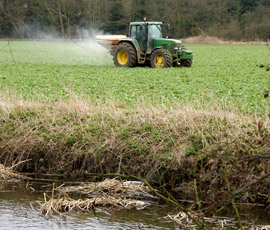New Scottish diffuse pollution rules in place

Farmers and crofters in Scotland are being reminded to pay attention to new diffuse pollution rules introduced on 1 July.
Following consultation on changes to the Controlled Activities Regulations last year, the Scottish government has introduced changes to General Binding Rules, which cover agricultural practices such as the storage and application of fertilisers and pesticides, siting of livestock feeders and cultivation of land adjacent to “the water environment”.
NFU Scotland criticised the original proposals, at the time warning there was a high risk they could be misinterpreted as a blanket ban on the use of fertiliser and pesticide on any ground higher than 12deg.
The amended changes were welcomed as more risk-based and proportionate and farmers were urged to acquaint themselves with them, said NFUS environment and land policy manager Andrew Bauer.
“NFUS knows this is a complicated subject and is working with the Scottish government, SEPA [Scottish Environment Protection Agency] and SRUC to produce plain English guidance for farmers, crofters and land managers on their legal responsibilities for protecting the water environment,” he said.
Prior to the publication of guidance, farmers with questions on the new rules were urged to contact the NFU Scotland head office or a local SEPA office.
New rules
• Fertiliser cannot be stored within 10m of the water environment – rivers, burns, ditches, wetlands, lochs, transitional waters and coastal waters
• Fertiliser cannot be stored on ground sloping towards the water environment unless it is ensured that any run-off fertiliser is intercepted – by a sufficient buffer zone or otherwise – to prevent it reaching the water environment
• With the exception of forestry operations, fertiliser cannot be applied to ground overlying gravel or fissured rock, where the average soil depth is less than 40cm. This is already the case in nitrate vulnerable zones, but until now outside NVZs the depth was 30cm
• Organic fertiliser cannot be applied within 10m of the water environment – this became part of cross-compliance in January 2012
• Livestock feeders must not be positioned within 10m of the water environment and must be sited in such a way to prevent run-off reaching the water environment
• No land may be cultivated for crops within two metres of the water environment, measured from the top of the bank. NFUS has been assured that in cases of gradually sloping land, this rule will be interpreted as being two metres from the last break in the slope before the water environment
• Pesticides and their application equipment must not be prepared, filled, cleaned or maintained within 10m of the water environment or any opening into a surface water drainage system
• Pesticides must be applied in accordance with the terms and instructions of the relevant product approval
• Pesticides must not be applied to frozen, snow-covered or waterlogged ground, unless it is required on waterlogged ground to control fungal disease
• Pesticides must not be applied within one metre of the top of the bank or shoreline adjacent to the water environment
• Pesticides must not be applied on ground sloping towards the water environment unless it is ensured any run-off is intercepted by the means of a sufficient buffer zone or otherwise
• Pesticides must not be applied within 50m of springs, uncapped wells or boreholes that supply water for human consumption
• Pesticides must not be applied during rainfall or when there is a risk that spray will drift or be blown out of the target area
• Pesticides and their packaging must not be stored within 10m of the water environment, or within 50m of springs, uncapped wells or boreholes that supply water for human consumption, or on an impermeable surface draining to a surface water drainage system. This rule does not apply when pesticides and their packaging are stored in such a way – a bunded store, for example – that means they cannot reach the water environment or any opening to a surface water drainage system.

